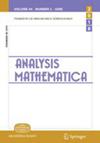A \((\phi_\frac{n}{s}, \phi)\)-Poincaré inequality on John domains
IF 0.5
3区 数学
Q3 MATHEMATICS
引用次数: 0
Abstract
Let \(\Omega\) be a bounded domain in \(\mathbb{R}^n\) with \(n\ge2\) and \(s\in(0,1)\). Assume that \(\phi \colon [0, \infty) \to [0, \infty)\) is a Young function obeying the doubling condition with the constant \(K_\phi< 2^{\frac{n}{s}}\). We demonstrate that \(\Omega\) supports a \((\phi_\frac{n}{s}, \phi)\)-Poincaré inequality if it is a John domain. Alternatively, assume further that \(\Omega\) is a bounded domain that is quasiconformally equivalent to a uniform domain (for \(n\geq3\)) or a simply connected domain (for \(n=2\)), then we show that \(\Omega\) is a John domain if a \((\phi_\frac{n}{s}, \phi)\)-Poincaré inequality holds.
约翰域上的 $$(\phi_\frac{n}{s}, \phi)$$ -Poincaré 不等式
让(\Omega\)是(\mathbb{R}^n\)中的一个有界域,具有(n\ge2\)和(s\in(0,1)\)。假设 \(\phi \colon [0, \infty) \to [0, \infty)\) 是一个遵守翻倍条件的Young函数,常数为 \(K_\phi<2^{/frac{n}{s}}/)。我们证明,如果 \(\Omega\) 是一个约翰域,那么它支持一个 \((\phi_\frac{n}{s}, \phi)\)-Poincaré不等式。或者,进一步假设 \(Omega)是一个有界域,它等价于一个均匀域(对于 \(n\geq3\))或一个简单连接域(对于 \(n=2\)),那么我们证明如果一个 \((\phi_\frac{n}{s}, \phi)\)-Poincaré不等式成立,那么 \(Omega)就是一个约翰域。
本文章由计算机程序翻译,如有差异,请以英文原文为准。
求助全文
约1分钟内获得全文
求助全文
来源期刊

Analysis Mathematica
MATHEMATICS-
CiteScore
1.00
自引率
14.30%
发文量
54
审稿时长
>12 weeks
期刊介绍:
Traditionally the emphasis of Analysis Mathematica is classical analysis, including real functions (MSC 2010: 26xx), measure and integration (28xx), functions of a complex variable (30xx), special functions (33xx), sequences, series, summability (40xx), approximations and expansions (41xx).
The scope also includes potential theory (31xx), several complex variables and analytic spaces (32xx), harmonic analysis on Euclidean spaces (42xx), abstract harmonic analysis (43xx).
The journal willingly considers papers in difference and functional equations (39xx), functional analysis (46xx), operator theory (47xx), analysis on topological groups and metric spaces, matrix analysis, discrete versions of topics in analysis, convex and geometric analysis and the interplay between geometry and analysis.
 求助内容:
求助内容: 应助结果提醒方式:
应助结果提醒方式:


